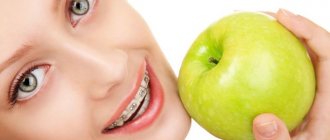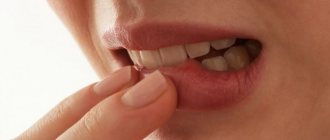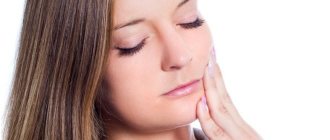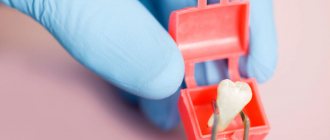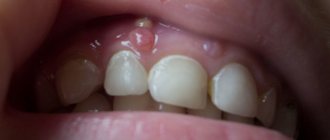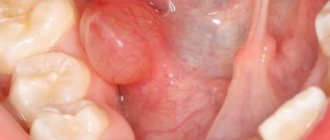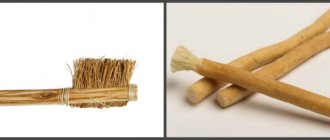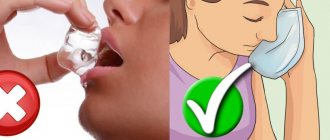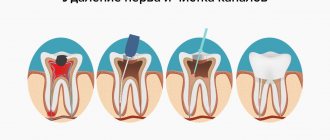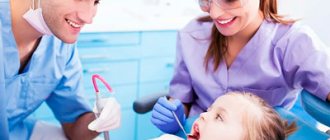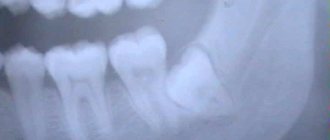Why is it important to chew food on both sides?
Not many of us think about and attach importance to how to chew food properly. Our physiology is designed in such a way that the distribution of activity of the masticatory muscles on the left and right sides of 60/40 and 70/30 is still acceptable, but when this is 100 percent activity of the masticatory muscles on only one side, a reflex inhibition (switching off, weakening) of the underlying muscles occurs on one side of the body. This situation can lead to various neurological symptoms. This bad habit is very often caused by missing teeth or the habit of chewing on one side after dental surgery.
In our body there is such a thing as “Myofascial chains”. This is a specific group of muscles connected to each other through fascia, which stretches from the feet to the skull (“Anatomy Trains” by Thomas W. Myers). The chain of muscles associated with the temporomandibular joint is called the deep ventral chain, which extends from the posterior tibial muscle of the ankle to the masseter muscles of the skull.
The effect of chewing gum on teeth: more disadvantages than advantages...
The effect of chewing gum - pros and cons
The effect of chewing gum on human health has both pros and cons. We will talk about them today.
In 1848, American entrepreneur John Curtis launched the production of chewing gum of his own invention. And at the end of the 19th century, chewing gum was first introduced, which, as advertised, “prevents tooth decay.” Nowadays, advertising also convinces consumers that chewing gum protects against caries and removes plaque. However, experts have their own opinion on this matter.
Ph balance and caries
Many manufacturers of chewing gum claim that it normalizes Ph balance. But, chewing gum in itself is not a means to reduce Ph levels in the oral cavity. During chewing, in the first 2-3 minutes, the salivary glands are activated, which contain a large number of systems that balance the condition of the oral cavity.
The acid balance in your mouth may change briefly depending on what food you just consumed. But a smart body itself is able to bring the Ph balance back to normal. Chewing gum can somehow affect it only if you chew it non-stop, including at night. And all statements about the effect of chewing gum on Ph-balance are purely a PR stunt.
Chewing gum manufacturers also say that chewing gum reduces the level of acidity in the mouth and, thus, protects teeth from caries. However, the Ph level does not reduce the risk of developing caries, which occurs locally under the influence of microorganisms. Microorganisms attack the enamel and hard tissues of teeth.
When a person chews chewing gum or vegetables, all that happens is self-cleaning of the chewing surfaces. Caries appears on the interdental teeth, which means that talking about the fight between chewing gum and caries can only be conditional.
"Sugarless"
Manufacturers advertise chewing gum with xylitol (“sugar-free”), positioning the effect of chewing gum as more beneficial for teeth. This chewing gum does not contain sugars that activate the development of microorganisms. Due to their activity, lactic acid is released, which destroys tooth enamel. However, if you don’t chew gum at all, there will be no sugar either, so there is no benefit from chewing gum with xylitol either.
There is an opinion that chewing gum promotes weight loss by dulling the feeling of hunger.
Indeed, occasionally, in order to avoid the temptation to grab something in between meals, you can chew gum. But this is strictly prohibited for people who have any problems with the gastrointestinal tract.
Composition of chewing gum
The main disadvantage of chewing gum is its composition.
Almost all chewing gum ingredients are obtained not from natural sources, but from chemical means. The basis of chewing gum is latex. It is believed that there is no particular harmful effect of chewing gum on the body, although full-fledged studies on this issue have never been conducted.
The flavors used to create chewing gum are natural or identical to natural. They can be harmful due to the fact that they are usually obtained chemically (through synthesis). But, in general, sanitary standards allow this.
Manufacturers add dyes to almost every chewing gum. E171, often found on packaging, was previously banned in Russia. This dye is also called titanium white. Now their use in food products is acceptable. But keep in mind that such a dye can cause liver and kidney diseases.
Harm
Dentists note that sometimes chewing gum is not only useless, but also harmful. Some people have overdeveloped chewing muscles, which results in increased abrasion of tooth enamel, and they are contraindicated from chewing gum.
Also, if you suffer from periodontal disease, have problems with tooth mobility, or use dental appliances, you should absolutely not use chewing gum, as chewing gum can contribute to tooth decay.
Chewing gum is contraindicated for those who have problems with the gastrointestinal tract. It irritates the gastric mucosa: when chewing gum enters a person’s mouth, the body perceives it as a product. The result of such an irritated stomach is gastritis and ulcers.
Chlorophyll (E140) and butylated hydroxytolol (E321) contained in chewing gum, along with menthol, can cause allergic reactions. Liquorice (or licorice), which is added to some chewing gum, increases blood pressure levels and reduces the amount of potassium in the blood.
Chewing gum - time
Constant chewing of gum can lead to overload of the periodontal tissues. Initially, nature provides the benefits of chewing. The pressure that is transmitted from the teeth to the gums creates a so-called massage of the gums and improves their blood circulation. But overloading these tissues is much more dangerous than underloading. Constant chewing leads to compression of the blood vessels in the gums and poor circulation. This is fraught with the development of inflammatory processes – periodontitis and gingivitis.
Those who constantly chew chewing gum experience increased salivation. Prolonged chewing loads the salivary glands, forcing them to constantly work. The consequence of this is that even when a person stops chewing, saliva continues to be released, and there is a desire to spit. This, of course, is not very aesthetically pleasing.
Some time after salivation has increased from constantly chewing gum, the reverse process begins. There is less and less saliva. And this has an extremely negative effect on digestion in general. The food does not receive the required amount of liquid and enzymes for its processing and enters the stomach in a large solid lump. This is where the first prerequisites for gastritis and ulcers begin.
Benefit
Of course, in some situations the influence of chewing gum is positive. For example, if you get carsick, chew gum and the nausea will go away. Chewing gum is also an essential item when traveling by plane. Chewing gum and, as a result, swallowing saliva will help with blocked ears.
Doctors do not say that chewing gum should not be used at all. For example, it is perfectly acceptable to chew it after eating to cleanse your mouth a little and freshen your breath. But this method cannot be considered the only possible one.
Sleep until lunch on weekends
Why can't you sleep until lunchtime on weekends? Unfortunately, if you don’t want to get problems with your well-being, you should reconsider the habit of sleeping on Saturdays and Sundays. Scientists from the University of Pittsburgh monitored the sleep and health of 447 volunteers. And they came to the conclusion that those who regularly try to compensate for a week of sleep deprivation over the weekend are more likely to have weight problems, elevated cholesterol levels and insulin resistance. Obviously, the reason is changes in metabolic processes associated with so-called circadian rhythms. But because the research is so new, scientists still have to work on a precise explanation. In the meantime, try to stick to a similar regime both on weekdays and on weekends, experts say.
As we all know, our two cerebral hemispheres are not functionally identical, one is creativity, the other is logic, synthesis, the other is analysis. The left hemisphere is very analytical and controls things in detail, mainly involved in word processing, speaking and writing, and other logical activities such as counting and calculation. The right hemisphere is exactly the opposite, trying to integrate everything. In fact, its main feature is holism, knowing the totality of essential details, such as the ability to recognize a person by detail or a symphony with one joke.
Lately, all you hear on TV is that without regular use of chewing gum, caries cannot be avoided. Nice advertising-looking doctors assure us that chewing gum is an essential component of dental care and effective prevention of dental diseases.
But does all this affect the mouth? The right side of the mouth is connected to the left hemisphere, the seat of logical-analytical rationality. From an archetypal point of view, here is a man, with his material and concrete behavior. According to Chinese medicine, this is the yang side.
The left side is associated with the right hemisphere, which is more associated with psychoactivity, with a predisposition towards art, spirituality and sensitivity. From an archetypal perspective, this is where the feminine manifestation occurs, and according to Chinese medicine, this is the yin side.
When there is balance between right and left, between yin and yang, between spirituality and materiality, there is also harmony and the mouth is balanced. Thanks to some studies done with functional magnetic resonance, it has been found that when we are waxy, we increase the activity of neurons in the cerebellum, cortex and thalamus.
But in childhood, parents only strove to take the chewing gum out of their mouths and throw it away, accompanied by tedious moral teachings about its dangers. Who to believe? Let's, together with our women's magazine, figure out what the pros and cons of chewing gum are, and then the answer to the question - to chew or not to chew will become obvious.
About the Orbit brand
Orbit chewing gum was introduced to the American market in 1944 by Wrigley. The company aimed to maintain sales in the face of shortages due to the war on some ingredients, in particular sugar.
Over time, sugar-free chewing gum has become a value in its own right. Dentists all over the world began to recommend using it to prevent the occurrence of caries.
Currently, the refreshing effect of Orbit gum is the last thing advertised. The first priority is to prevent gum and dental diseases. Regular use of Orbit 10-15 minutes after meals stimulates salivation, which protects teeth.
The mineral complex included in chewing gum also helps strengthen them.
What is the benefit of chewing cloves every day?
- Boosting immunity. Cloves are a good source of vitamin C, a water-soluble antioxidant that promotes immune defense by acting as a barrier against pathogens and oxidative stress. This in turn helps strengthen the immune system and promote proper immune function.
- Promotes oral health. Chewing cloves is beneficial, cloves have antimicrobial, anti-inflammatory and antibacterial properties that help reduce the formation of plaque, gingivitis and other gum diseases in the mouth. A study found that cloves can stop the growth of four types of bacteria that cause gum disease.
- Promoting liver health. Cloves are rich in eugenol, a bioactive compound with anti-inflammatory and antioxidant properties that may help protect against liver damage and counteract the signs of cirrhosis. This study is conducted on animals and further studies in humans are needed to prove its effectiveness.
- Regulate your blood sugar levels. The presence of eugenol in cloves helps control blood sugar levels. This compound may increase insulin secretion, improve glucose tolerance and beta cell function, thereby reducing blood glucose levels.
- Improved digestion. Cloves contain many beneficial bioactive compounds that stimulate the secretion of digestive enzymes and help speed up the digestion process. Cloves reduce stomach acidity, help reduce gas formation and fight nausea.
- May prevent tumor growth. The study showed the antitumor activity of ethyl acetate extract of cloves. Cloves have therapeutic properties that can help treat cancer.
- Help with weight loss. Clove extract may reduce the risk of obesity resulting from a high-fat diet. Eating cloves can help reduce belly fat, reduce body weight and liver fat, cloves are very beneficial for weight loss.
- Strengthening and restoring bones. Cloves are an excellent source of manganese, calcium and magnesium, which promote bone formation and improve bone health. Additionally, the presence of eugenol in cloves has been shown to be effective in increasing bone density and strength.
- Ulcers of the lower stomach. Stomach ulcers form in the lining of the stomach and cloves can help treat them. Cloves can stimulate the production of stomach lining, which acts as a protective barrier and prevents erosion of the stomach lining caused by digestive acids.
- Improved respiratory health. Cloves can be used to treat a number of respiratory conditions such as bronchitis, asthma, colds and coughs. This is mainly due to the anti-inflammatory properties of cloves, which help reduce inflammation in the respiratory tract.
- Improved skin health. The antibacterial and antifungal properties of cloves can help treat acne and improve overall skin health. This is one of the reasons why clove oil is used to treat acne by fighting the inflammation caused by acne.
Asymmetry: why one side of the face looks better than the other
Primarily calcium.
There is Orbit on the market in various flavors, as well as a children's version in a bright red wrapper.
Massive television advertising used by the manufacturer to promote the brand in Russia led to the high popularity of the product. So, the group “Spleen” has a song “Orbit without sugar”.
In 2008, Wrigley, which owns the Orbit brand, was absorbed by the Mars concern.
Anastasia (August 28, 2014)
Orbit
Why were orbits taken off sale?
567
just super
this is the best chewing gum I love all its flavors
Andrey
Russia
Your ORBIT is similar to our asphalt! Also, half of the components are not installed!
777
Don't know
The chewing gum may be good, but the advertising is just terrible
Katerina
and my favorite orbit eucalyptus
I have withdrawal symptoms.. I want orbit-eucalyptus, why was it discontinued?? who knows??? and will there still be such chewing gum?)
Ganiya
replaces the brush
At our pace of life, we are not always able to truly brush our teeth correctly. I mean the oral cavity during the day. So, this chewing gum replaces our counting machine and saves a lot of time in addition to just having a nice function.
Olga
my favorite orbit eucalyptus
I have been chewing orbits since 1998. I started with vintefresh, then eucalyptus, and now, after its discontinuation, I chew cool mint. I'm hoarding wrappers. There are already almost 3 thousand pieces available!! really looking forward to some kind of giveaway between orbit fans and wrapper collectors!!
Gulya
very good chewing gum
I like its consistency and the fact that when you chew it it doesn’t fall apart into pieces. And also its pleasant taste and aroma have saved me more than once.
When writing a review, try to describe
all the advantages and disadvantages of the Orbit brand
Reviews are published after preliminary moderation.
When can you chew on the side of an extracted wisdom tooth?
You are viewing the Recommendations , located in the large Wisdom section.
Removing the figure eight is more difficult compared to other teeth.
This is due to their location and the presence of powerful, curved roots.
The latter quite often interfere with extraction and can even break off .
Correct behavior after wisdom tooth extraction promotes rapid wound healing and helps avoid various complications .
To make the operation less painful and easier , surgeons ask patients to follow a number of rules :
- Come to the procedure on a full stomach (except when general anesthesia is planned). This way the patient relaxes better and the blood clots faster.
- Remove eights in the morning . At this time, the body better tolerates a stressful situation . If the tooth extraction took place in the morning, by the evening the pain will decrease and the person will be able to sleep peacefully.
- Do not drink alcohol the day before . They worsen the rheological properties of the blood, which is accompanied by the appearance of significant edema and prolonged bleeding.
- If the patient notices severe anxiety, you should take sedative medications (Motherwort, valerian tincture, Tenoten).
The doctor bends the gum and grabs the figure eight with forceps. He makes rotational and rocking movements to extract the wisdom tooth. The vessels that fed the pulp are damaged, which leads to heavy bleeding . Nerve endings transmit a signal about injury. This is accompanied by severe pain , which manifests itself after the anesthetic wears off.
The operation is acutely perceived by the body . The hole is intensively supplied with blood. An inflammatory process develops in the affected area : leukocytes enter here through blood vessels.
Wisdom teeth on the upper jaw are easier and less painful . On the lower jaw, the bone tissue is denser and includes a branched root system. To avoid adverse consequences, you must strictly follow the rules .
Care of the hole is one of the important aspects of rapid wound healing after such manipulation and prevention of complications. General recommendations include:
- Do not make sucking movements from the hole, so as not to remove the blood clot.
- Eat warm, soft food.
- Chew food on the opposite side of the teeth.
- Wash with antiseptic solutions.
- Take all medications prescribed to the patient by the attending physician.
Attention! Removing figure eights, especially in the lower jaw, is accompanied by severe pain . in the surgeon’s recommendations is to take painkillers .
After 10–20 minutes, the patient can spit out the tampon installed by the surgeon. This should not be done before : this can damage the formation of a blood clot on the tooth socket.
Half an hour after the intervention, the patient is allowed to take a painkiller tablet . The surgeon prescribes the following drugs:
During the first three hours, you must refrain from eating food or hot drinks . Active facial expressions should so as not to provoke divergence of the seams. The patient should sleep on the side where the doctor removed the wisdom tooth.
At this time, the patient suffers from pain in the jaw, and sometimes the temperature rises to 38°C. A person can apply ice wrapped in a towel to their cheek. This will ease his condition and prevent frostbite on his skin.
The patient must follow the doctor's recommendations:
- Eating liquid food : include thick, porridge-like soups in your diet.
- Avoid hot and cold foods and sweets .
- Take prescribed medications.
- Stop rinsing to allow the blood clot in place of the tooth to harden. It's better to take baths . The patient needs to take a herbal decoction or antiseptic solution into his mouth and hold it for several minutes.
During this period, tissue is formed , from which new epithelium is formed. The patient should rinse his mouth with antiseptic solutions (Furacilin, weak solution of potassium permanganate, Miramistin).
Usually after 3–4 days a person feels relief . The pain has decreased and the painkillers can be stopped. If the swelling of the cheek does not subside during this time, you should consult your doctor.
7 days after the operation, the connective tissue has completely filled the hole, and new epithelium begins to form . If there is no swelling or temperature, the patient stops rinsing.
It is recommended to continue to eat non-solid foods . Dishes should not be hot or cold. The patient carefully takes care of the oral cavity , brushes his teeth 2 times a day.
Photo 1. X-ray of the patient showing where the wisdom tooth is cutting and the inflamed gum.
Photo 2. Sometimes after removing a wisdom tooth, doctors put temporary sutures on the socket.
Photo 3. Before and after the removal surgery, the blood clot closes the open wound and protects the socket
At this time, the epithelium has fully grown , and bone tissue formation begins. The gums recover within 3–4 weeks after the intervention.
The patient should not forget about oral care . It is necessary to thoroughly brush your teeth twice a day , rinse your mouth after every meal.
- It is forbidden to brush your teeth for 1–2 days .
- Do not touch the hole with your tongue or touch it with sharp foreign objects or fingers.
- Do not eat hot or too cold foods or sweets .
- Do not chew food on the side where the tooth was removed.
- Do not overcool until the wound is completely healed.
- Do not heat the cheek in the area of the operated hole.
- Do not visit baths, saunas, or take a hot bath.
- Do not drink alcoholic beverages.
- Do not take blood thinning medications for the first three days.
If the patient is not attentive enough to his health, he may develop various complications :
- Inflammatory process.
- Swelling of the soft tissues of the cheek.
- The appearance of a hematoma on the face.
- Bleeding from the socket.
- Difficulty opening the mouth.
- Seam divergence.
Dentists ask you to follow special rules that help the wound heal faster.
- Try to avoid the extraction site for the first three days after surgery.
- It is advisable to make small circular movements . They must be slow and careful.
- Use a soft bristle brush.
- In the first few days, you should not spit out toothpaste so as not to damage the clot on the hole. It is better to rinse your mouth with saline solution. At the end of the procedure, you should tilt your head to the side and let the liquid drain .
- Be sure to clean your tongue so that pathogenic microbes do not get into the hole.
On the third day , the wound heals and the patient can begin brushing his teeth in the usual way.
When removing wisdom teeth, surgeons often perform these manipulations. To extract the eights, he has to make 1-2 incisions on the gum . To make the hole heal faster, the doctor applies stitches.
For the procedure, the doctor uses absorbable material . This avoids additional trauma to the operated area.
Usually the threads in the hole dissolve in about 20–30 days . The patient does not have to go to the dentist to bandage and remove the suture material. He should visit the doctor in 1-2 weeks to make sure that the operation did not cause complications.
Important!
You should not
yourself . Such actions can lead to the development of inflammation and bleeding from the socket.
When removing the figure eights, the surgeon places thin rubber strips . This is drainage. It prevents the hole from closing and is necessary for removing pus and blood from the operated area.
The strip is installed for 4–5 days . During this time, the patient should not try to pull it out . However, in some cases, the drainage falls out on its own ahead of time. Don't worry: this usually doesn't lead to complications .
On days 4–5, the surgeon examines the wound. If all the pathological fluid has come out and the swelling subsides, he removes the drainage. Then the doctor prescribes various medications that will speed up the regeneration of the wound.
When the figure eights are removed, the integrity of the vessels feeding the root is disrupted . This may lead to bleeding.
If the patient receives physical activity, blood circulation increases . Pressure increases in the injured vessels of the socket.
For three days the patient will have to completely eliminate physical activity . At this time, it is prohibited to go to fitness, to the gym, to the pool, or to perform other activities accompanied by active movements.
To avoid the development of adverse consequences, the patient must strictly comply with all doctor’s prescriptions after surgery.
General recommendations that will help you understand how to behave after surgery:
- Avoid rinsing your mouth and brushing your teeth on the first day after surgery.
- Try not to disturb the wound : do not touch the hole with your tongue, do not pick here with sharp objects.
- Do not eat for the first two hours after surgery.
- Chew on the side opposite to the removal for three days after removing the figure eights.
- Avoid sudden temperature changes : avoid visiting saunas, baths, and taking a hot bath.
- Avoid alcoholic beverages and solid hot foods.
- Use antiseptic solutions for rinsing (Furacilin, Chlorhexidine, weak solution of potassium permanganate).
We advise you to read: Blood when brushing your teeth dream book
Watch the video in which the patient talks about the sensations after wisdom tooth removal.
The effectiveness of recovery after wisdom tooth removal depends on compliance with medical recommendations . If the patient is not careful about his health, serious complications may develop . This is why it is so important to follow all the surgeon’s instructions.
source
Infection and inflammation of the socket is often a consequence of the removal of molars. The healing of the hole under the “eight” is especially difficult. Dentists always warn you about what needs to be done after wisdom tooth removal and how to prevent complications. But even before the procedure, it would not hurt the patient to learn about the basic, generally accepted rules of nutrition and oral care after extraction.
A direct indication for the removal of the third molar may be:
- inflammatory process at the root;
- cyst;
- compression of the branches of the trigeminal nerve;
- lack of space;
- caries;
- anatomically incorrect position, due to which a chronic bite of the soft tissues of the cheek develops;
- pathological location inside the jaw, causing pressure on neighboring teeth.
In all these situations, you need to part with the wisdom tooth. The decision to remove is made by two doctors: a dental therapist and an oral surgeon. The first is obliged to correctly assess the clinical picture, the second is to think through the course of the operation.
At the preparatory stage, the dentist examines, interviews the patient and studies an x-ray to clarify the position of the roots. Before the procedure, the person receives general anesthesia or local anesthesia (depending on the complexity of the access). The surgeon then uses forceps to pull out the top of the tooth and remove debris from the gums. The resulting hole is disinfected.
In special situations, the doctor may decide to sew up the edges of the hole with threads; in other cases, the patient goes home to recover.
Immediately after surgery, the doctor will close the wound with a sterile cotton swab. You cannot remove it from the mouth for 30 minutes, during which time the bleeding will stop completely and a blood clot will form, protecting the cavity from germs and bacteria. It is prohibited to remove or clean out a clot without a doctor’s instructions.
On the first day after the procedure, it is better to stay at home. If your condition allows, you can sleep. For acute pain, the doctor will prescribe painkillers; you should not refuse them. They not only improve well-being, but also help relieve inflammation.
Socket after removal of the third molar
Special recommendations concern nutrition. 3 hours after the removal of the wisdom tooth, when it is already possible to drink and eat, the following are allowed:
- drinks at room temperature;
- liquid dishes;
- puree soups;
- porridge.
You need to eat with a teaspoon, opening your mouth slightly. It is more convenient to drink drinks through a cocktail straw. It is necessary to ensure that no pieces of food fall into the hole or liquid is poured in; to do this, food must be placed on the side opposite to the wound.
Important! In the evening of the first day, you should stop brushing your teeth so as not to damage the clot. The maximum that can be done is to carefully rinse your mouth with cooled boiled water.
For a few more days after a person has had a tooth removed, his jaw will hurt, which is absolutely natural. Also, many dentists consider it normal for the temperature to rise to 38.5 °C. If the temperature rises to 39–40 ° C, and the pain does not decrease under the influence of painkillers, you should urgently call an ambulance or contact the emergency dentist.
On the second and third days after the wisdom tooth removal procedure, you can apply cold compresses. Ice slices, frozen foods and hot water bottles filled with cold water should be wrapped in a soft cloth on top to protect the skin from frostbite. You should also follow the recommendations of your doctor:
- eat liquid food (the diet may include thick, porridge-like soups);
- avoid hot and cold;
- give up sweet, spicy and sour foods;
- take the prescribed medicine.
You should not chew food on the side from which the tooth was removed or clean the wound with a brush. During this period, rinses with herbs are already allowed; you need to care for damaged gums using decoctions of chamomile, oak bark or sage. You should rinse your mouth carefully - too much action will slow down recovery.
Important! If the temperature rise repeats (the temperature rose, then returned to normal, and after 3-4 days it increased again) and if the toothache intensifies, you need to consult a dentist. Despite proper care, inflammation may develop after wisdom tooth removal. Only a doctor can assess its scale and seriousness of the situation. Repeated heat and pain in the affected gum area are symptoms of complications.
If all the recommendations after wisdom tooth removal are followed, by the end of the first week there will be noticeable relief: the wound heals and the pain subsides. In case of complications, the doctor will prescribe an additional medicine – an antibiotic. The tablets are taken in a course until a lasting therapeutic effect is obtained.
You cannot stop the antibiotic prescribed by your doctor on your own. Diseases such as alveolitis, gum inflammation, and phlegmon may develop.
Nutrition after wisdom tooth removal should remain gentle for two weeks. You can make fruit purees, eat boiled vegetables, drink non-hot herbal tea. When the wound heals, you can diversify your diet: include fresh fruits, meat and fish dishes in the menu.
Everyone knows that you should not eat for 3-4 hours after wisdom tooth removal, but few are aware of how many days you need to avoid heavy physical activity. Doctors often forget to warn patients about this before discharge.
When a tooth is pulled out, the integrity of a large number of blood vessels feeding its root is disrupted. The faster they heal, the less likely there are complications. When the body receives physical activity, blood circulation increases - pressure on injured vessels increases. In this regard, you cannot visit a fitness studio, lift weights, swim or perform any active activities for two weeks after extraction.
Cigarettes will also have to be put away for a while. Hot tobacco smoke promotes bleeding and can dissolve protective blood clots. The plug will come out, leaving a wound in the hole that is open to infection. This will not so much complicate care as it will increase the wound healing time and lead to complications.
Some symptoms of malaise during the first month after extraction may be due to the fact that the person has recently had a tooth removed. In addition to a swollen cheek, pain and fever, the patient should be alert to:
- unusual headache;
- persistent putrid odor from the mouth;
- throbbing pain in the jaw from which the “wise” tooth was pulled out;
- feeling of numbness in the gums;
- enlargement of lymph nodes located near the operation site.
After the patient contacts the clinic, the doctor will examine his oral cavity, order an x-ray or open his gums. Its task is to eliminate the source of inflammation and suppress the spread of bacterial infection. Since all procedures are painful, anesthesia will be performed. If the patient took a painkiller before visiting the dental clinic, he should notify the doctor about this.
Important! It is forbidden to open abscesses and ulcers on your own, or take antibiotics without a dentist’s prescription. Illiterate wound treatment and the wrong choice of drug contribute to the development of inflammation and general intoxication of the body.
Since active rinsing of the mouth can disrupt the protective clot, dentists recommend using medicinal baths instead. The most effective:
- Decoctions of calendula and eucalyptus (3 tablespoons per cup of boiling water).
- Chlorophyllipt (ready-made pharmaceutical preparation).
- Saline solution (25 grams per glass).
- Miramistin.
- Chlorhexidine.
It is very convenient to make baths on the lower jaw - just take the solution into your mouth, hold it for 4 minutes, and spit it out. Under the force of gravity, the liquid will penetrate into all hard-to-reach places and provide effective anti-inflammatory care.
It is much more difficult to care for the socket after the removal of the upper wisdom tooth (and it has to be pulled out just as often as the lower one). The recipes can be used the same, but the methods should be different:
- for the correct location of the liquid in the mouth, you need to tilt your head to the side (in the direction on which the operation was performed);
- the second option is a gauze application (you need to moisten a folded sterile napkin with a medicinal infusion and apply it to the gum).
Important! Cotton wool should not be used for either the upper or lower jaw. Its fibers remain in the wound and can cause suppuration. To care for the hole, you can only use sterile bandages and gauze wipes.
Even with careful preparation for surgery, the patient’s condition after having a hard-to-reach third molar pulled out is far from ideal. During this period, it is difficult to remember all the advice: how to care for the wound, what to exclude from your regular diet. For convenience, all the main recommendations are shown in the illustration:
We advise you to read: When the nerves on the front tooth are removed
Looking at it, it’s easy to remember how long you can eat after wisdom tooth removal, when to clean your mouth, and how to eat properly. Following the basic rules will help keep the hole in order and avoid complications.
source
Not knowing for sure that we need the eights that appear in adulthood, we receive information about their condition only during a consultation with a dentist or if they cause pain. Every doctor will say that most often it is better to exclude a possible problem due to these chewing elements that do not always fully appear. And everyone advises eliminating them. This can be difficult due to their difficult accessibility, and if wisdom teeth are removed, sometimes some symptoms may occur that do not occur in normal situations.
Therefore, do not neglect the doctor’s advice, if you were given recommendations after the removal of a lower or upper wisdom tooth, try to follow them all. This is important because an implantation operation was performed and at the same time an element was torn out from the soft tissues.
The manipulation is shocking, and if it was carried out with a complex plan, then the rules of what to do when removing a wisdom tooth will be necessary to get out of a difficult period for the body.
At the heart of the so-called problem, when it is necessary to remove a wisdom tooth, recommendations for the operation are given due to the fact that almost always figure eights create a problem for a person’s healthy condition.
Statistics show that the inflammation mechanism starts at different ages. You shouldn’t expect this, since most likely it will happen anyway, especially since the indication for surgery is their location.
In the vast majority of cases, it is incorrect and creates unfavorable conditions for destruction for neighboring elements.
But you must understand that after wisdom tooth removal, there may be some difficulties with recovery. Having decided on manipulation, it is better to have little idea about its complexity. And for a good end to the process, you also need to know what to do after wisdom tooth removal.
Having information about such a problem, every person should think about eliminating the problem in advance, even when nothing is bothering them. Moreover, even in a healthy state, the result may not be predictable.
After wisdom tooth removal, recommendations are given and must be followed.
In each case, after a wisdom tooth has been removed, if you adhere to them, you will more easily endure the period of local recovery.
Redness and swelling of soft tissue in the area of root removal
After a dental procedure, you do not need to immediately check the condition of the gums with your tongue or start rinsing your mouth.
- increase local blood flow with heat, including drinking or eating hot food;
- During the first 24 hours, or better yet for two or three days, do not swim in hot water or take a bath.
The rules of what not to do after wisdom tooth removal include one more aspect of normal hygiene. In the first days, mechanical treatment of the teeth with a brush is not carried out. If you are left with a tampon at the site of injury, you need to carefully remove it after no more than 20-30 minutes.
Tips on what to do when a wisdom tooth has been removed, that is, those that need to be followed, include the use of baths with an antiseptic on the second day. In addition to the rules, there is also a reminder about what you can eat when your wisdom tooth is pulled out. You can't eat solid foods. It is better to eat ground food, not coarse types of cereals, dairy products, and avoid sour and spicy foods so as not to irritate the mucous membranes.
In the event that the surgeon did not tell you what to do when your wisdom tooth is removed, these rules will help you cope with the situation.
source
Tooth extraction involves serious manipulation, so the body may react negatively to the resulting stress. To prevent problems, it is recommended to adhere to simple rules that contain some restrictions. Strict adherence to all requirements will make the postoperative period comfortable and calm. Read the list of what not to do after tooth extraction and be sure to follow it.
The patient’s behavior after the procedure determines the further healing process of the wound in the mouth. Tooth extraction is a serious manipulation, so experts recommend observing the following restrictions:
- Remove the tampon from the hole before 25-30 minutes
If the operation to extract a tooth is successful, the bleeding is stopped by inserting a tampon into the hole. There is no need to remove it before, nor do you need to remove it by hand. Even on clean hands there are many microbes that, upon contact, will penetrate into the oral cavity and cause infection of the hole. It is enough to spit out the tampon (cotton wool).
- Rinse your mouth for the first couple of days after surgery
This ban may seem to many to be a mistake, because treating a wound is, in fact, considered commonplace. However, such procedures prevent the formation of a blood clot at the site of the extracted tooth. Therefore, it should be carried out only with the advice of a doctor. The process itself is performed carefully, without intense exposure to a jet of liquid on the well. It is enough to take the solution into your mouth and hold it in the wound area for 5-7 minutes, then spit it out.
- Smoking and drinking alcohol
When smoking after a tooth has been pulled out, the harmful tars contained in tobacco get onto the open wound of the oral cavity. And alcoholic drinks, or more precisely the ethyl alcohol from which they are produced, irritate sensitive areas and the socket. In addition, under the influence of alcohol, the blood clot is washed out of the hole, which deprives the wound of its protective layer. Bad habits increase the chances of developing infectious diseases and inflammation in the oral cavity.
- Consume foods made from fermented milk products
The presence of open wounds in the mouth requires the exclusion of fermented milk products from the menu. An acidic environment creates favorable conditions for the development of pathogenic microflora, resulting in inflammation of the oral tissues.
- Do sports or hard work
Physical activity increases blood circulation, which can cause bleeding from the socket. Prolonged healing of the wound creates a favorable environment for the development of complications, which are always more difficult to cure.
- Expose the body to hypothermia or overheating
Overheating or hypothermia of the body ends in inflammation. In this case, the process of tissue cell regeneration is extended over a long period. Inflammation is a provoking factor in the development of more serious problems in the oral cavity.
After tooth extraction, it is recommended to apply cold to the cheek. This helps to slow down the growing swelling and dull the pain in the mouth. You should also remember about the strict prohibitions that apply in the first hours after a tooth is pulled out:
- Do not drink any liquid for an hour;
- Plan your first meal after 2.5-3 hours;
- do not rinse your mouth;
- postpone physical activity;
- do not take a hot bath;
- limit the heating of the cheek with compresses or warm bandages;
- Avoid taking medications that have a blood-thinning effect (for example, aspirin);
- do not exert any influence on the socket (touch the blood clot with your finger, lick it);
- give up bad habits (alcohol and smoking) for at least a couple of weeks.
On the first day, on the advice of specialists, you should exclude sports and postpone heavy physical work. After stress, the body must direct energy and strength to restore oral tissues; overwork and tension can provoke a negative reaction. You should also not visit beaches, bathhouses, or massage parlours. Under the influence of high temperatures, blood circulation increases, which often provokes resumption of bleeding.
We advise you to read: The gums of the wisdom tooth hurt and the tooth has grown
The rehabilitation period after tooth extraction must be accompanied by adherence to a strict diet. You need to remove sweets, spices, and spicy foods from your diet. All products with a hard structure should be crushed before use. Chewing movements should be carried out with the healthy side of the jaw so as not to impact the socket and prevent some food from getting into the open wound. To prevent inflammation in the oral cavity, it is recommended to periodically rinse with a herbal decoction or antiseptic solution.
Important! People suffering from hypertension are advised to consult with their doctor regarding the use of medications. It is better to control the pressure during the wound healing period so as not to provoke bleeding from the hole.
On the second and subsequent days, you cannot use untested remedies or folk recipes to relieve pain or swelling. It is much safer to use effective and well-proven herbal preparations or decoctions.
Immediately after surgery to remove a tooth from your mouth, you should follow simple rules that will prevent the development of complications:
- 15-25 minutes after the end of the operation, you need to remove the tampon. If the bleeding does not stop, you should seek qualified help. The specialist will examine the wound and decide whether to install another bandage in the hole or prescribe a special hemostatic drug.
- If after the end of the anesthesia you feel aching pain at the site of the lost tooth, you can take one of the painkillers prescribed by the specialist.
- your tongue or hands to influence the hole; this interferes with the formation of a protective layer (blood clot).
- drink water or a neutral drink (not sweet!) after 1 hour. And eating is allowed only after 2-3 hours.
- to the side of the cheek where surgery was performed for 15 minutes at intervals of 20-40 minutes (you can apply ice and hold it for 10-15 minutes). This will help stop the growth of swelling of the soft tissues of the mouth.
- Avoid eating hot, spicy and sweet foods. All this irritates the tissues of the mouth and slows down the healing process of the wound.
- If you experience heat, fever, severe bleeding or increasing swelling, which occurs 3 days after the dentist’s manipulations, you should immediately consult a doctor. This symptomatology is serious and requires the participation of a specialist.
- Oral hygiene is not canceled, but it should be done very carefully, especially in the socket area. The blood clot should remain intact.
During the rehabilitation period after tooth extraction, the oral cavity requires careful care:
- Every 2-3 hours you need to rinse your mouth with chamomile decoction or another antiseptic, but the procedure should be carried out 1-2 days after the operation. The process itself is more reminiscent of baths, since intense impact on the hole is prohibited.
- Perform oral hygiene carefully , without affecting the socket. Use a soft brush so as not to damage the wound.
- Develop a special diet ; dishes should be warm and not contain hard pieces, so as not to irritate the tissues of the mouth.
- Chewing functions are temporarily transferred to the teeth of the opposite jaw. Loading the socket can cause bleeding. In addition, there is a high probability of food particles penetrating inside, which creates favorable conditions for the development of pathogenic microflora in the oral cavity.
- To prevent swelling, it is recommended to apply cold compresses every 10-20 minutes for no more than 10 minutes. It is better to do this in the first hours after tooth extraction surgery, when swelling begins to actively develop.
- When eating or performing hygiene and preventive procedures , it is not recommended to open the jaw too much.
During the healing period of the hole after tooth extraction, the dentist prescribes medications taking into account the condition of the patient’s oral tissues and the degree of complexity of the operation. Most often, the following means are used to quickly recover and prevent the development of complications:
- Lymphomyosot (drops) – improves lymph outflow, prevents the development of microorganisms, relieves inflammation, strengthens the immune system;
- Suprastin, Claritin (tablets) - recommended for allergic manifestations;
- Analgin, Solpadein, Ketanol (tablets) - help get rid of pain in the mouth;
- Traumeel (tablets) – stops bleeding in the socket, relieves pain, stimulates regenerative function in the oral cavity;
- Paracetamol (tablets) – prescribed as an antipyretic;
- Cholisal (gel) – used for applications to eliminate pain effects, prevent the development of pathogenic microflora in the mouth;
- Flemoxin, Tsifran, Lincomycin are broad-spectrum antibiotics;
- Chlorhexidine, Furacilin - used for mouth rinsing as an antiseptic.
What should you not do after wisdom tooth removal?
Removing a wisdom tooth involves a number of serious manipulations, which increases the chances of inflammation or infection of the wound.
To prevent various problems after tooth loss, the doctor prescribes antibiotics. Therefore, bad habits are strictly prohibited. You should carefully select other medications to avoid a negative reaction from the body or a decrease in the effectiveness of the medications taken.
How long should you not eat after tooth extraction?
An interval of two to three hours should be maintained between the tooth extraction operation and the consumption of food. In this case, it is important that the bleeding be stopped spontaneously or forcibly (with drugs).
When can you drink water?
After an hour you can drink water. You should give up sugary and carbonated drinks, as well as fruit juices for a while (until the hole heals).
When can I remove the bandage (tampon)?
The bandage must be removed 15-25 minutes after the end of the tooth extraction operation. You should not do this with your hands to avoid infection. It is enough to spit out the tampon.
How long will the bleeding last?
By compressing the gums with a cotton or gauze swab, bleeding stops in 10-30 minutes. Even during the first day after tooth loss, slight bleeding is possible. If bleeding from the hole is severe, you should immediately contact the clinic.
Is it possible to smoke?
After tooth extraction surgery, smoking is prohibited. This is due to the negative effects of the resins that make up tobacco. It's better to forget about the obsessive habit for a couple of weeks. If you have an irresistible desire to smoke, you can use an electronic cigarette or follow at least 2-3 day restrictions.
Can I drink (alcohol)?
Alcohol is also prohibited. Ethyl alcohol helps wash out the clot from the socket, and it also neutralizes the effect of painkillers. In addition, it causes bleeding (due to its ability to increase blood circulation). If antibiotics or hemostatic agents are prescribed, then when they are combined with alcohol, dangerous chemical compounds are formed. It is impossible to predict the consequences of such a cocktail.
Ideally, refrain from drinking alcohol for two weeks while the hole in your mouth heals.
When are stitches removed?
In case of difficult tooth extraction, sutures are placed on the gums. This is done in order to speed up the healing process and prevent the penetration of microbes into the hole. The stitches can be removed after 7-10 days, when the tissues have tightened. All this time, the threads are periodically treated with an antiseptic solution.
What to do if the pain does not go away, swelling or bruising appears?
Tolerable pain, swelling, and bruising are considered acceptable consequences after tooth extraction if the symptoms begin to subside on the 4th day. If there is unbearable pain or rapidly developing swelling in the mouth or cheek, medical attention is required. These signs may indicate complications or serious problems.
Advice! To eliminate these symptoms, it is recommended to apply cold to the cheek on the first day after surgery and take an anesthetic medication to relieve pain in the mouth.
What can be done at the site of the extracted tooth?
It is recommended to restore the integrity of the dentition after tooth loss by installing orthopedic structures: a bridge, a removable denture, an implant. Preference is given to implantation; the implanted pin prevents bone tissue atrophy and makes the artificial tooth functional. Other options only solve the aesthetic problem.
source
Home | Food products | Food | The whole truth about chewing gum
Chewing gum contains components that we try to avoid in regular products.
Chewing gum is as symbolic of America as Coca-Cola or McDonald's. It is believed that it was in America in 1848 that a certain enterprising John Curtis was the first in the world to “bake” chewing gum for sale in his oven. Since then, the United States has been ahead of the rest in the production of all kinds of toffee.
In the modern Russian chewing gum market, demand shapes supply. The buyer has developed a strong preference for chewing gum with a pronounced hygienic and medical, primarily dental, effect: protection against caries, teeth whitening, breath freshening...
We decided to find out why chewing gum is useful and harmful, for which we sent five samples of chewing gum for examination to the Research Institute of Nutrition of the Russian Academy of Medical Sciences.
Chewing gum consists of a rubber base or goma base. Typically these are synthetic polymers with the addition of resin from coniferous trees or the sap of the Sapodilla tree, which grows in Central America. In addition, chewing gum contains sweeteners, flavors, dyes, preservatives, thickeners, stabilizers, glazing agents - that is, everything that we try to avoid in regular products. Does this mean that chewing gum can be dangerous?
The results of our examination showed that all the samples provided contain sugar substitutes, the norms of which do not go beyond the limits. But there are nuances.
The content of some substances in products is not regulated by Russian legislation. Therefore, for example, the indicators of such sweeteners as maltitol, xylitol and sorbitol differ tenfold.
It is important to know that sorbitol and xylitol, unlike maltitol and aspartame, are natural sweeteners. Sorbitol is obtained from grapes, apples, and rowan. Xylitol - from corn cobs and cotton seed husks.
There is an opinion that if there is no sugar in a product, then there are no calories. Actually this is not true. For example, xylitol and sorbitol are almost equal in calorie content to regular sugar. But what they don’t write about on the packages of chewing gum is that xylitol has side effects.
What happens if you chew food on only one side?
If overeaten, it can cause stomach upset and have a laxative effect.
As for aspartame, numerous researchers accuse it of having a negative effect on health, in particular, it can depress the nervous system. And for patients with phenylketonuria, it is vitally important to prevent aspartame from entering the body.
The US Federal Food Administration has received thousands of consumer complaints about aspartame, accounting for 80% of all complaints about dietary supplements.
Mentos and Orbit chewing gum contained the least amount of aspartame. Other manufacturers have 4-5 times more. By the way, the composition of children's chewing gum is practically no different from the composition of “adult” chewing gum. Some even contain aspartame. The difference is mainly in taste. This should be taken into account when buying chewing gum for a child. By the way, chewing gum was never included in the list of healthy products.
Is it true that chewing gum...
...is it better without sugar? Chewing gum with sugar is harmful. Sugar is the favorite food of microorganisms; they use it in their vital functions and release more acid, which destroys enamel.
...fights tooth decay? Sweeteners, in particular xylitol and carbamide, have a different formula; microbes cannot use them. According to numerous studies, sweeteners are considered caries preventive. During chewing, salivation is activated, and saliva has bactericidal effects and transfers calcium ions to the tooth, strengthening it. Remains of food are washed away or removed mechanically, and teeth are less damaged.
...whitens teeth? This is said loudly. Chewing gum, or rather saliva, washes away the remnants of tea, coffee, and other food - that is, it cleans the tooth, but does not make it whiter than it is. But the wording “whitening” is officially approved for use in the characteristics of chewing gum by the European Food Commission.
…effective in large quantities? It is enough to chew one pad, and not two, as we are encouraged to advertise.
...replaces brushing your teeth? Never. Chewing gum is just an addition to a toothbrush and floss. In general, after eating you need to brush your teeth. And if this is not possible (at work, on the road), you can rinse your mouth with water and chew gum.
...pulls out fillings? If the filling is of high quality, it cannot be pulled out with chewing gum.
By the way, chewing gum is enough for no more than 10 minutes 3-4 times a day. If you chew longer, the oral cavity comes into contact with the external environment. And all the germs will collect in your mouth. It should be used only after meals. If you chew just like that, a reflex is triggered: saliva is released, then gastric juice, but food does not come in - this ultimately leads to thinning of the mucous membrane, as a result of which there is a high probability of exacerbation of ulcers and gastritis.
Repost on social networks:
QUALITY.RU on social networks:
Tweets from @kachestvo_ru
Is it worth correcting occlusion problems?
You can get used to the peculiarities of appearance. Fortunately, facial features are not the only factor that determines the general idea of a person. But if the dentist has identified a violation of the occlusion of the teeth, then it is better to correct them. There are several reasons for this:
- uneven teeth are something that a person constantly remembers, so the smile is not as sincere as one would like;
- a decrease in the height of the teeth due to abrasion of the enamel visually adds age to a person, making him much older than he actually is;
- improper distribution of the load when chewing causes degenerative-dystrophic changes in the temporomandibular joint, which over time begins to click and hurt;
- malocclusion leads to changes in the tone of the muscles of the face and neck, which leads to changes in posture;
- Constantly increased muscle mass leads to poor circulation and provokes persistent headaches;
- Crooked teeth make speech unclear.
The use of aligners and braces allows you to correct malocclusions at any age. At first, orthodontic treatment will require financial costs and the need to endure some discomfort, but in the long term it will avoid many problems.
Sugar-free chewing gum
The composition of modern chewing gums includes a chewing base (to bind all ingredients), sweeteners - sugar, corn syrup or sweeteners (sorbitol, maltitol syrup, xylitol, aspartame, acesulfame-k), fragrances, flavoring additives, softeners (to create the appropriate consistency during chewing time), stabilizers, emulsifiers, dyes, glazing agent, as well as active ingredients - fluorine, urea, sodium bicarbonate, herbal extracts, etc. Chewing gum, which contains OI - 1.0% dry cocoa shell extract, has been patented in the USA. suppressing glucan synthesis.
Most modern sweeteners do not release acids during metabolism under the influence of oral microorganisms.
